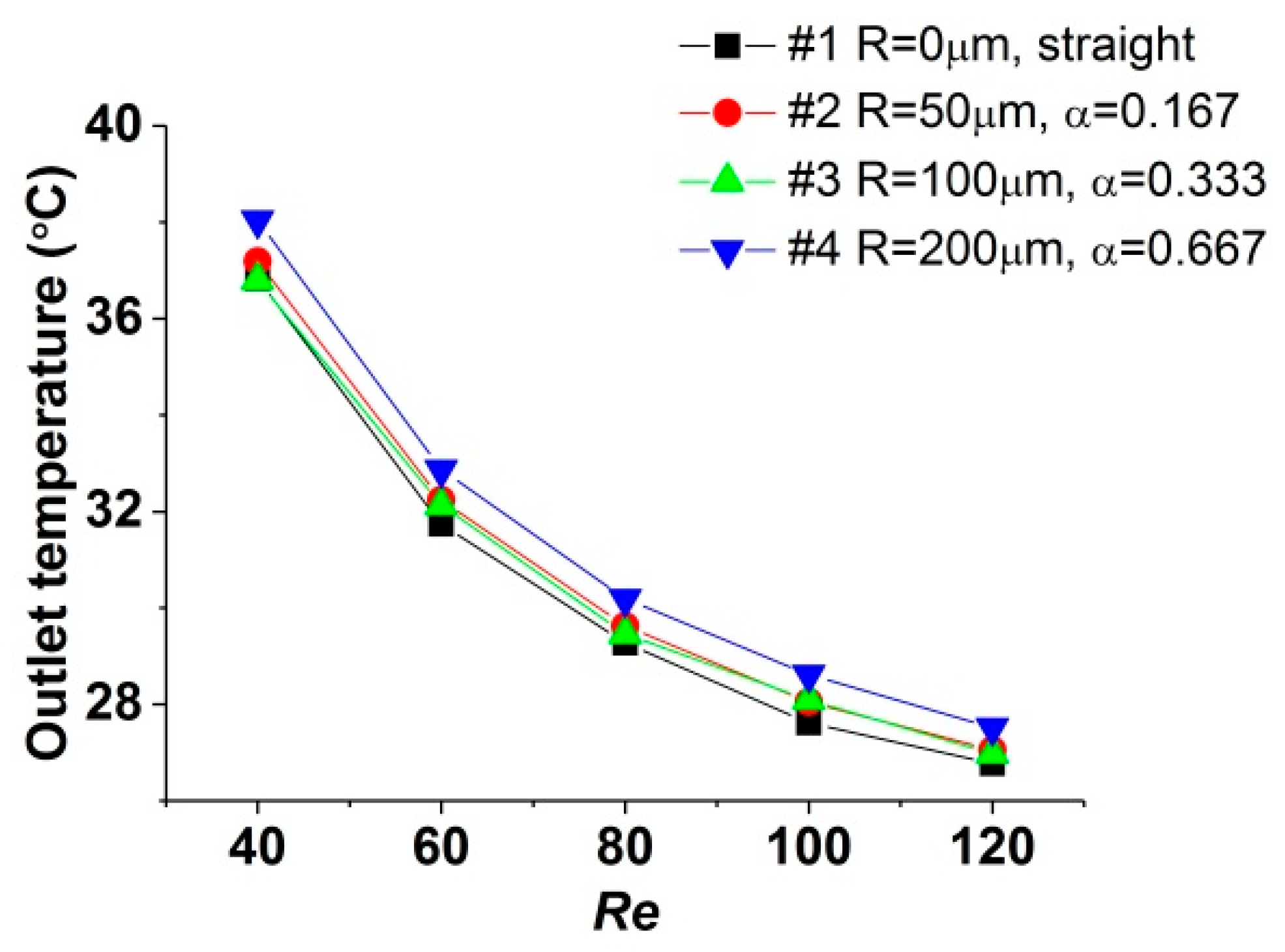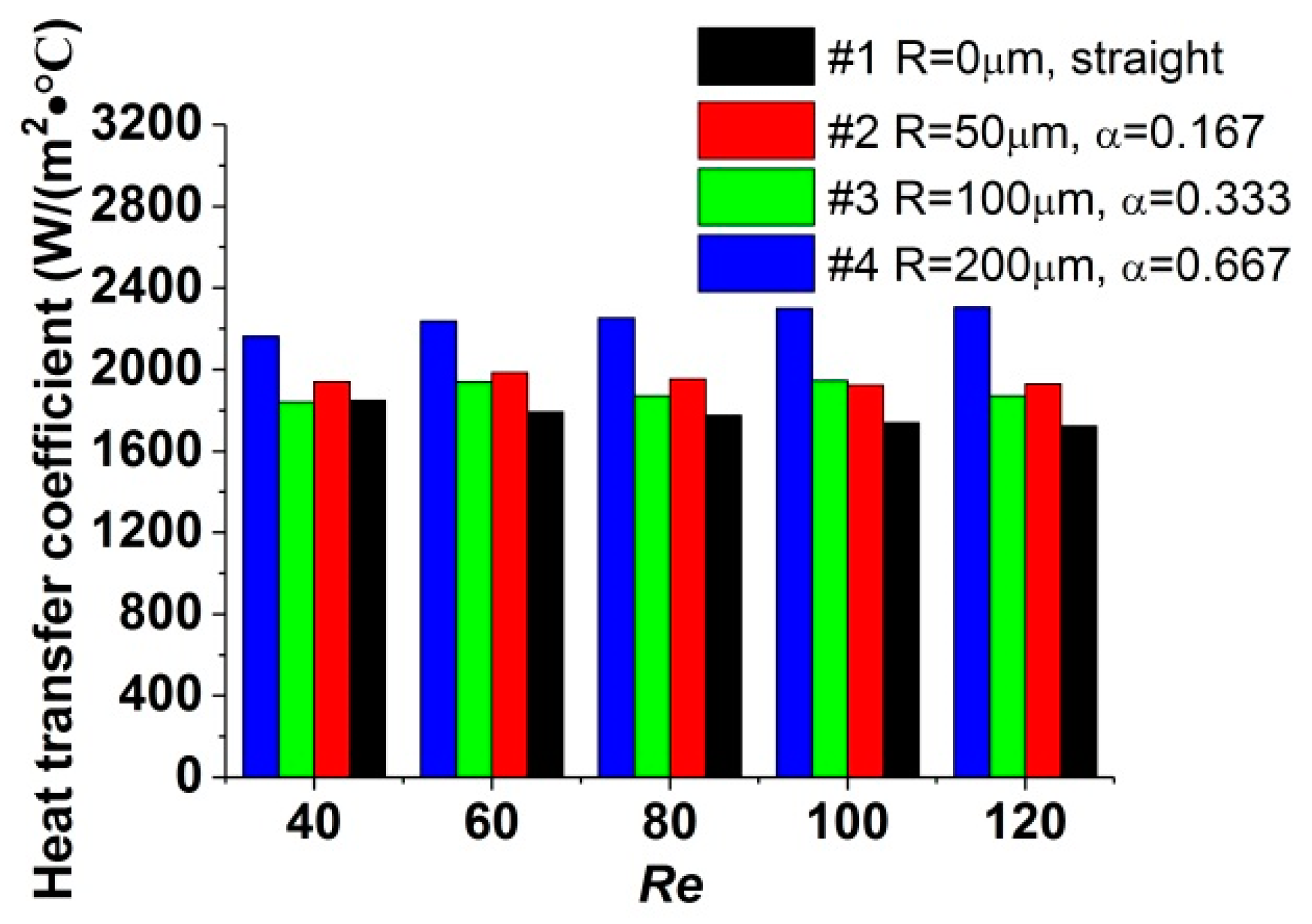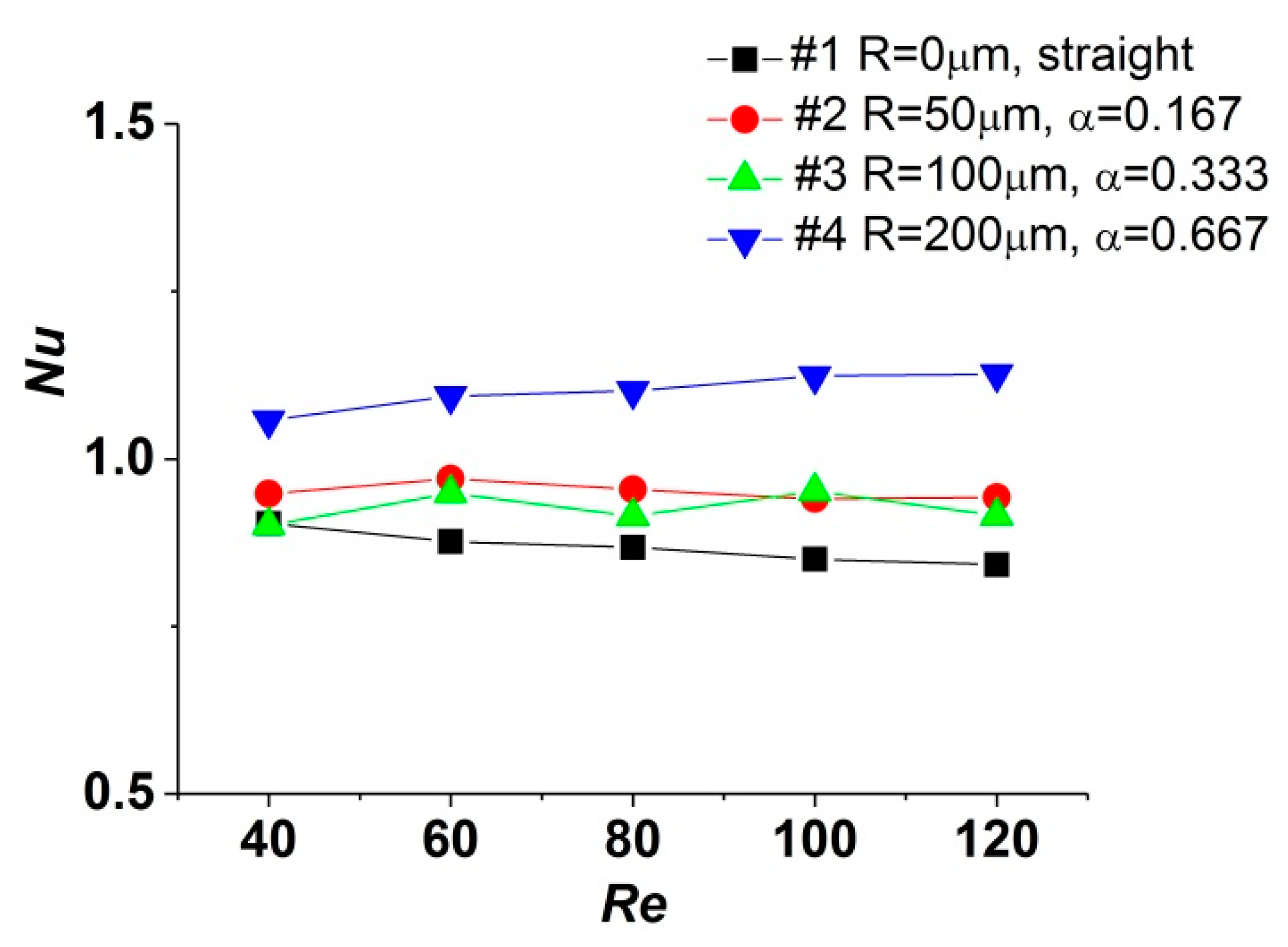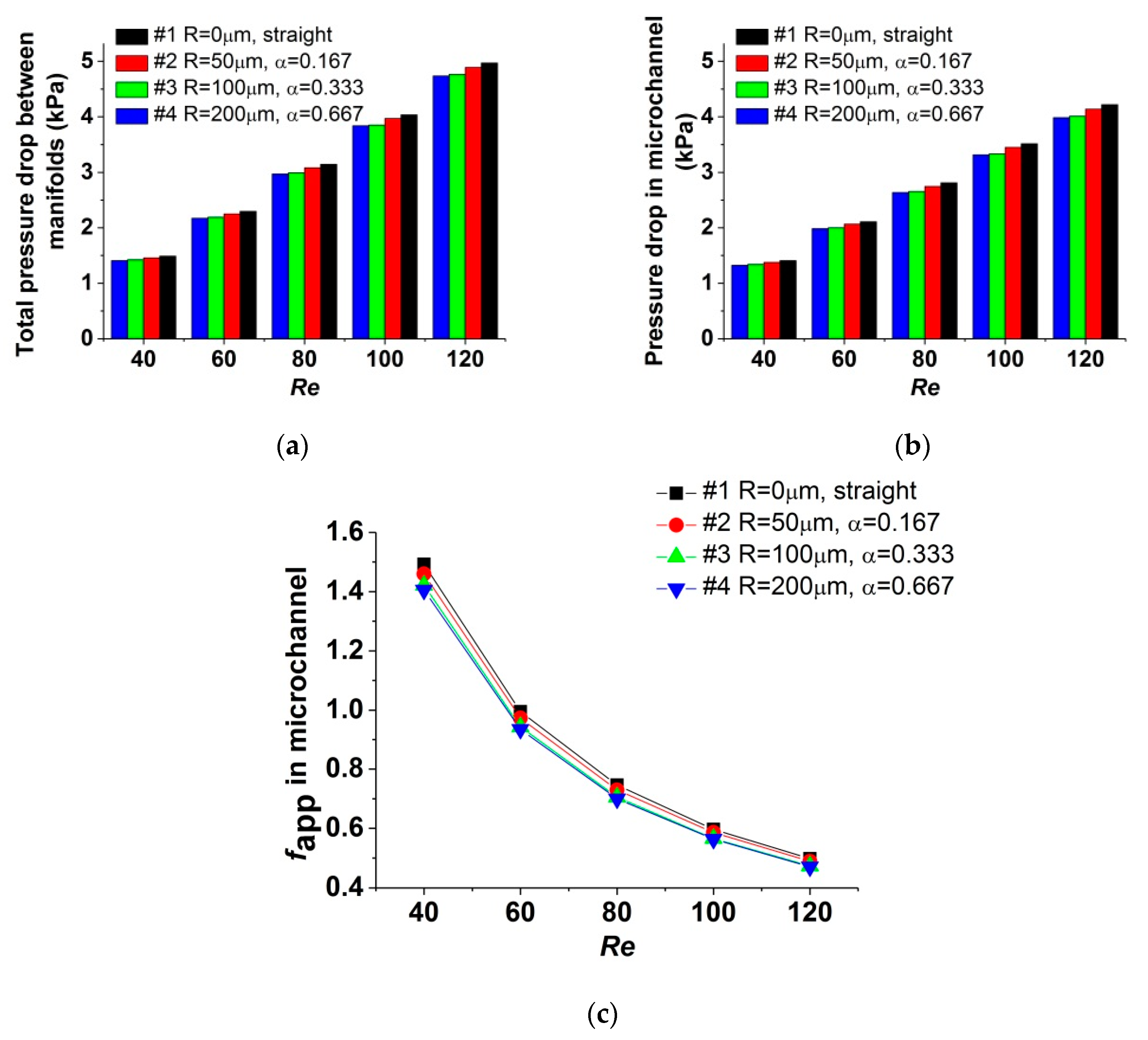Experimental Investigation of the Flow and Heat Transfer Characteristics in Microchannel Heat Exchangers with Reentrant Cavities
Abstract
:1. Introduction
2. Materials and Methods
2.1. Microchannels Fabrication
2.2. Experimental Setup
3. Data Analysis
3.1. Hydraulic Performance
- (1)
- Pressure drop caused by friction inside the microchannel.
- (2)
- Extra pressure loss at the inlet/outlet of microchannel on account of the abrupt contraction and expansion.
- (3)
- Extra pressure loss on account of the passage bends of manifolds.
- (4)
- Extra pressure loss at the inlet/outlet manifolds on account of the cross-sectional area change.
3.2. Thermal Performance
3.3. Experiment Uncertainty
4. Results and Discussion
4.1. Heat-Transfer Characteristics
4.2. Pressure-Drop Characteristics
4.3. Performance Analysis
5. Conclusions
- (1)
- Compared with the straight one, the heat-transfer capacity in microchannels with reentrant cavities is enhanced. For the ranges of parameters analyzed in this study, the Re number has a limited impact on the heat transfer. When the radius of reentrant cavities increases, the variation of the convective heat-transfer coefficient is complicated and depends on the heat-transfer deterioration at the expansive surface and the enhancement at the contractive surface in cavities. For the range of radius investigated, it is considered that a critical radius may exist which could minimize the capacity of heat transfer.
- (2)
- The Nu numbers of microchannels, with or without reentrant cavities, showed different tendencies as the Re number increased. Increasing the radius of reentrant cavities could enhance the mixture of the fluid near the walls and reduce the temperature gradient. Therefore, the decrease of the Nu number is restrained. Additionally, the Nu numbers obtained in this investigation are lower than theoretical values for conventional scale channels, indicating that the magnitudes of conduction thermal resistance and convection thermal resistance are approximate.
- (3)
- The reentrant cavities could reduce the pressure drop in microchannels, compared with the straight one. The radius of cavities could significantly affect the capacity of pressure-drop reduction when the test sections are unheated. When the test sections are heated, the different heat-transfer capacity of test sections causes deviation in the fluid temperature and viscosity; thus, the effect of pressure drop reduction is further influenced.
- (4)
- Compared with the straight one, the overall performance of microchannels with reentrant cavities is improved, due to the enhancement in heat transfer and the reduction in pressure drop. The radius of reentrant cavities and the Re number could affect the overall performance significantly. For the ranges of structural parameters and the Re number investigated, test section #4 yields the best overall performance factor when Re = 120.
- (5)
- Due to the characteristics of enhancing heat transfer and reducing pressure drop, adding reentrant cavities in microchannel heat exchangers is an ideal approach to improve performance, especially for devices which are sensitive to the increase of pressure drop or pumping power consumption; hence, ribs or fins could not be adopted.
Author Contributions
Funding
Conflicts of Interest
Nomenclature
| a | half of the width of the microchannel, μm |
| total effective convective heat transfer area, | |
| b | half of the height of the microchannel, μm |
| fluid specific heat capacity, J/kg°C | |
| distance of two adjacent cavities, μm | |
| hydraulic diameter of microchannel, μm | |
| fapp | apparent friction coefficient |
| friction factor of the straight microchannel | |
| function depended on a/b | |
| h | local convective heat transfer coefficient, °C) |
| fin surface heat transfer coefficient, °C) | |
| height of microchannel, μm | |
| pressure loss coefficient for a 90° bend | |
| sudden contraction coefficient | |
| sudden expansion coefficient | |
| inlet manifold loss coefficient | |
| outlet manifold loss coefficient | |
| length of microchannel, mm | |
| N | number of parallel microchannels |
| Nu | Nusselt number |
| Nu number of the straight microchannel | |
| m | fin parameter |
| fluid mass flux, | |
| q | heat flux, |
| pressure drop caused by sudden contraction, Pa | |
| pressure drop in the microchannel, Pa | |
| pressure drop caused by sudden expansion, Pa | |
| pressure drop in the inlet manifold, Pa | |
| pressure loss, Pa | |
| pressure drop in the outlet manifold, Pa | |
| total pressure drop between inlet/outlet manifold, Pa | |
| R | radius of reentrant cavities, μm |
| Re | Reynolds number |
| average of the temperature measured by the four thermocouples, °C | |
| fluid characteristic temperature, °C | |
| fluid inlet temperature, °C | |
| fluid outlet temperature, °C | |
| Wall temperature, °C | |
| V | total fluid volumetric flow rate |
| average velocity in the microchannel, m/s | |
| velocity in the inlet manifold, m/s | |
| velocity in the outlet manifold, m/s | |
| width of microchannel, μm | |
| Greek letters | |
| dimensionless parameter, (=R/) | |
| dimensionless parameter, (=R/) | |
| fluid density, | |
| fluid dynamic viscosity, Pas | |
| fluid thermal conductivity coefficient, W/m°C | |
| thermal conductivity coefficient of silicon, W/m°C | |
| overall performance factor | |
| fin efficiency | |
| area ratio | |
References
- Wang, R.; Wang, J.; Yuan, E. Analysis and optimization of a microchannel heat sink with V-Ribs using nanofluids for micro solar cells. Micromachines 2019, 10, 620. [Google Scholar] [CrossRef] [PubMed] [Green Version]
- Liu, Z.; Qin, S.; Chen, X.; Chen, D.; Wang, F. PDMS-PDMS micro channels filled with phase-change material for chip cooling. Micromachines 2018, 9, 165. [Google Scholar] [CrossRef] [PubMed] [Green Version]
- Mario Di Capua, H.; Escobar, R.; Diaz, A.J.; Guzmán, A.M. Enhancement of the cooling capability of a high concentration photovoltaic system using microchannels with forward triangular ribs on sidewalls. Appl. Energy 2018, 226, 1601–1680. [Google Scholar]
- Ling, W.; Zhou, W.; Yu, W.; Zhou, F.; Chen, J.; Hui, K.S. Experimental investigation on thermal and hydraulic performance of microchannels with interlaced configuration. Energy Convers. Manag. 2019, 174, 4394–4452. [Google Scholar] [CrossRef]
- Duan, Z.; Ma, H.; He, B.; Su, L.; Zhang, X. Pressure drop of microchannel plate fin heat sinks. Micromachines 2019, 10, 80. [Google Scholar] [CrossRef] [PubMed] [Green Version]
- Tuckerman, D.B.; Pease, R.F.W. High-performance heat sinking for VLSI. IEEE Electron Device Lett. 1981, 5, 126–129. [Google Scholar] [CrossRef]
- Gunnasegaran, P.; Mohammed, H.; Shuaib, N.; Saidur, R. The effect of geometrical parameters on heat transfer characteristics of microchannels heat sink with different shapes. Int. Commun. Heat Mass Transf. 2010, 37, 1078–1086. [Google Scholar] [CrossRef]
- Weilin, Q.; Mala, G.M.; Dongqing, L. Pressure-driven water flows in trapezoidal silicon microchannels. Int. J. Heat Mass Transf. 2000, 43, 353–364. [Google Scholar] [CrossRef]
- Wang, G.; Hao, L.; Cheng, P. An experimental and numerical study of forced convection in a microchannel with negligible axial heat conduction. Int. J. Heat Mass Transf. 2009, 52, 1070–1074. [Google Scholar] [CrossRef]
- Tiselj, I.; Hetsroni, G.; Mavko, B.; Mosyak, A.; Pogrebnyak, E.; Segal, Z. Effect of axial conduction on the heat transfer in micro-channels. Int. J. Heat Mass Transf. 2004, 47, 2551–2565. [Google Scholar] [CrossRef]
- Herman, C.; Kang, E. Heat transfer enhancement in a grooved channel with curved vanes. Int. J. Heat Mass Transf. 2002, 45, 3741–3757. [Google Scholar] [CrossRef]
- Dharaiya, V.V.; Kandlikar, S.G. A numerical study on the effects of 2d structured sinusoidal elements on fluid flow and heat transfer at microscale. Int. J. Heat Mass Transf. 2013, 57, 190–201. [Google Scholar] [CrossRef]
- Hong, F.; Cheng, P. Three dimensional numerical analyses and optimization of offset strip-fin microchannel heat sinks. Int. Commun. Heat Mass Transf. 2009, 36, 651–656. [Google Scholar] [CrossRef]
- Xia, G.D.; Chai, L.; Wang, H.Y.; Zhou, M.; Cui, Z. Optimum thermal design of microchannel heat sink with triangular reentrant cavities. Appl. Therm. Eng. 2011, 31, 1208–1219. [Google Scholar] [CrossRef]
- Ghani, I.A.; Kamaruzaman, N.; Sidik, N.A.C. Heat transfer augmentation in a microchannel heat sink with sinusoidal cavities and rectangular ribs. Int. J. Heat Mass Transf. 2017, 108, 1969–1981. [Google Scholar] [CrossRef]
- Pan, M.Q.; Wang, H.Q.; Zhong, Y.J.; Hu, M.L.; Zhou, X.Y.; Dong, G.P.; Huang, P.N. Experimental investigation of the heat transfer performance of microchannel heat exchangers with fan-shaped cavities. Int. J. Heat Mass Transf. 2019, 134, 1199–1208. [Google Scholar] [CrossRef]
- Phillips, R.J. Forced Convection, Liquid Cooled, Microchannel Heat Sinks. Master’s Thesis, Massachusetts Institute of Technology, Cambridge, MA, USA, 1987. [Google Scholar]
- Shah, R.K.; London, A. Laminar flow forced convection in ducts. In Advances in Heat Transfer (Suppl. 1); Irvine, T.F., Hartnett, J.P., Eds.; Academic Press: New York, NY, USA, 1978. [Google Scholar]
- Remsburg, R. Thermal Design of Electronic Equipment; CRC Press: Boca Raton, FL, USA, 2001. [Google Scholar]
- Shaughnessy, E.J.; Katz, I.M.; Schaffer, J.P. Introduction to Fluid Mechanics; Oxford University Press: New York, NY, USA, 2005. [Google Scholar]
- Yun, H.; Chen, B.; Chen, B. Numerical simulation of geometrical effects on the liquid flow and heat transfer in smooth rectangular microchannels. In Proceedings of the ASME International Conference on Micro/Nanoscale Heat and Mass (Transfer 3), Shanghai, China, 18–22 December 2009; MNHMT2009-18413. pp. 271–277. [Google Scholar]
- Yin, L.F.; Jia, L. Confined bubble growth and heat transfer characteristics during flow boiling in microchannel. Int. J. Heat Mass Transf. 2016, 98, 114–123. [Google Scholar] [CrossRef]
- Moffat, R.J. Describing the uncertainties in experimental results. Exp. Therm. Fluid Sci. 1988, 1, 3–17. [Google Scholar] [CrossRef] [Green Version]
- Tso, C.P.; Mahulikar, S.P. The use of the Brinkman number for single phase forced convective heat transfer in microchannels. Int. J. Heat Mass Transf. 1998, 41, 1759–1769. [Google Scholar] [CrossRef]
- Tso, C.P.; Mahulikar, S.P. Experimental verification of the role of Brinkman number in microchannels using local parameters. Int. J. Heat Mass Transf. 2000, 43, 1837–1849. [Google Scholar] [CrossRef]
- Choi, S.B.; Barren, R.R.; Warrington, R.Q. Fluid flow and heat transfer in micro-tubes. ASME DSC 1991, 40, 89–93. [Google Scholar]
- Hetsroni, G.; Gurevich, M.; Mosyak, A.; Rozenblit, R. Drag reduction and heat transfer of surfactants flowing in a capillary tube. Int. J. Heat Mass Transf. 2004, 47, 3797–3809. [Google Scholar] [CrossRef]








| Parameter | Maximum Uncertainty (%) | Parameter | Maximum Uncertainty (%) |
|---|---|---|---|
| Temperature (°C) | ±0.5 | Reynolds number | ±1.74 |
| Flow rate (mL/min) | ±0.5 | Friction factor | ±3.58 |
| Pressure drop (kPa) | ±3.13 | Heat transfer coefficient °C) | ±1.33 |
| Hydraulic diameter (μm) | ±1.67 | Nusselt number | ±2.13 |
© 2020 by the authors. Licensee MDPI, Basel, Switzerland. This article is an open access article distributed under the terms and conditions of the Creative Commons Attribution (CC BY) license (http://creativecommons.org/licenses/by/4.0/).
Share and Cite
Huang, B.; Li, H.; Xu, T. Experimental Investigation of the Flow and Heat Transfer Characteristics in Microchannel Heat Exchangers with Reentrant Cavities. Micromachines 2020, 11, 403. https://doi.org/10.3390/mi11040403
Huang B, Li H, Xu T. Experimental Investigation of the Flow and Heat Transfer Characteristics in Microchannel Heat Exchangers with Reentrant Cavities. Micromachines. 2020; 11(4):403. https://doi.org/10.3390/mi11040403
Chicago/Turabian StyleHuang, Binghuan, Haiwang Li, and Tiantong Xu. 2020. "Experimental Investigation of the Flow and Heat Transfer Characteristics in Microchannel Heat Exchangers with Reentrant Cavities" Micromachines 11, no. 4: 403. https://doi.org/10.3390/mi11040403
APA StyleHuang, B., Li, H., & Xu, T. (2020). Experimental Investigation of the Flow and Heat Transfer Characteristics in Microchannel Heat Exchangers with Reentrant Cavities. Micromachines, 11(4), 403. https://doi.org/10.3390/mi11040403




